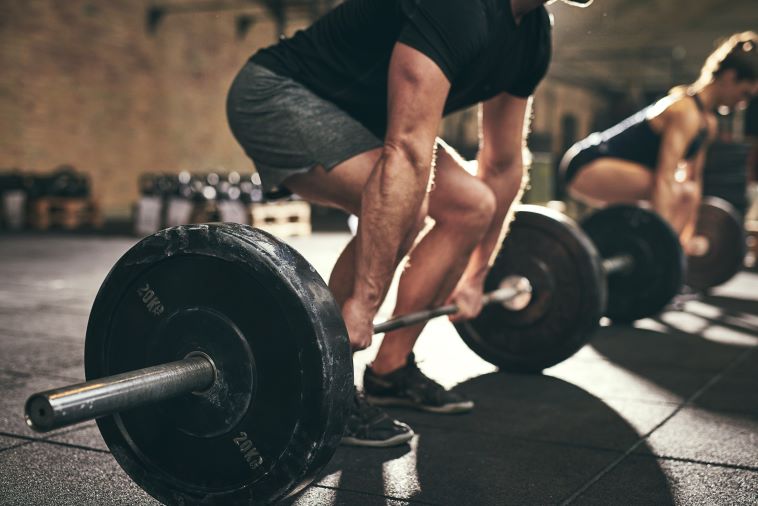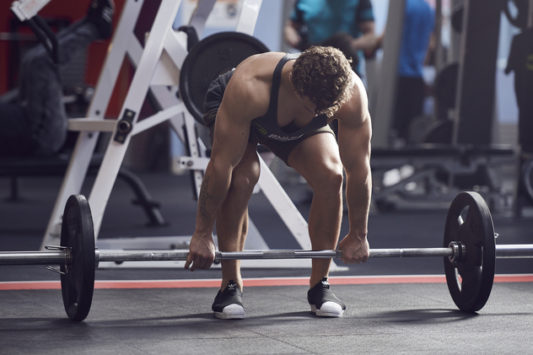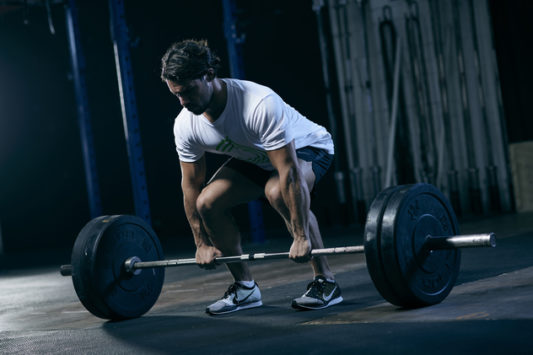The “Rack Pull” is a variation of the deadlift. This exercise is used to improve strength in the deadlift movement, and also as a compound exercise which has great hypertrophy benefits for the back, in particular the lower back.
When performing regular deadlifts, a lot of people struggle to keep their back straight and form perfect, which causes the upper back to round and place uncomfortable pressure on the lower back. This could be the reason you feel tightness the next day after performing deadlifts.
4 Steps to Improve Your Deadlifting Ability
In order to minimise the risk of back pain and improve your deadlift, there are a few things you can do.
- Firstly, you should decrease the weight you’re attempting to deadlift. If you can’t lift the weight using correct form, the activity is counter-productive in terms of hypertrophy and strength progress.
- Then, ensure your starting position is strong. Take a minute to set up your stance, keep your feet planted and your buttocks back. Holding the bar, ensure you retract your scapular and hinge the hips back slightly so that the lower back becomes arched inwards.
- When performing the movement, press off from the heels and keep your weight back while lifting the bar and keeping the shoulders retracted throughout.
- Make sure you have adequate flexibility in the hips and ankles; if you cannot reach a perfect parallel squatting position you may need to perform some more flexibility and mobility work in order to enable yourself to achieve the correct form.
Tips: Make sure you use Olympic size weight plates so that the starting height of the bar is not too close to the floor.
Lifting the weight from the floor up to the knees is the hardest part of the deadlift, as this is when the most resistance is occurring. If you’re noticing that you can’t keep your form perfect throughout the first half of the lift, you may need to strengthen your lower back. This is where rack-pulls come in.
Benefits of Rack-Pulls
It’s difficult to find exercises that target the lower back and allow you to lift enough weight to challenge your muscles to increase in strength and size. The rack pull allows you to perform just the top half of a deadlift, so the most difficult portion of the movement is skipped in order to allow progression to be made by using heavier weights than you can usually deadlift just within the lock-out phase of the exercise.
This means that by increasing the resistance used for the top half of the movement, the muscles are forced to adapt and become stronger; resulting in a carryover of strength to the full deadlifting movement. Additionally, the hypertrophy benefits of Rack Pulls enable the lower back to grow and provide more support when performing big compound movements such as the deadlift and squats.
Performing Rack-Pulls in 3 Easy Steps
There are a few variations of rack pulls which you may wish to progress through. The general rule of thumb is the higher the bars starting position is, the easier the lift will be to perform. As a guideline, I would advise the following three positions as a means of progression (You’ll need to alter the height of the rack you’re pulling from, to these positions).
1: Two inches above the knee – This position will be the easiest form of the rack-pull and the most comfortable starting position to reach. Allowing you to create a very strong starting position beneath the bar in order to keep strict form and generate the most power throughout the movement.
2: Immediately above the knee – Starting with the bar placed just above the knee cap, this position is the most common starting point for the rack pull, which is slightly more difficult than the previous, but still focuses solely on the lock-out of the movement.
3: Immediately below the knee – Beginning the movement just before the halfway point of the lift. This variation allows you to become more comfortable in the transition from the lift off the ground, to the lock-out.
8 Form and Set-Up Tips
Your starting position for the rack-pull is very important. Ensure every repetition is performed with perfect form and follow these guidelines.
- Set the rack height with the bar at your desired position. Approach and take hold of the bar with arms just wider than shoulder-width slightly outside of the knees.
- Hold the bar using either an overhand grip or a mixed grip (one hand overhand, one underhand).
- Place your feet shoulder-width apart, and while holding the bar, retract your shoulder blades and pull your buttocks down while hinging the hips slightly so that an inward arch is created in the lower back – ensure the bar is sitting on your legs at the desired starting position.
- Taking in a deep breathe, ensure your posture is tight and that you’re ready to begin the movement
- Exhale and push off from the heels while also keeping your weight back on the heels. Maintain a strong upper body posture and make sure the upper back does not arch forwards.
- Allow the hips and knees to extend whilst maintaining your arch in the lower back and shoulder retraction.
- Perform the lift until lockout, and then gradually return the weight to the rack via the same technique with strong form.
- Do not begin your consequent repetitions until the bar is static and you have created your initial starting position again.
Tips: Perform rack pulls 1-2x per week for optimal results. Allow at least 48 hours rest between workouts including this exercise.
Take-Home Message
Rack-Pulls are fantastic for improving strength and size in the lower back. They can be used as a great progression towards the deadlift and should always be performed using the correct technique to minimise the risk of injury.
ABOUT THE AUTHOR
George Platt is a Personal Trainer, Online Coach and Fitness/Nutrition Writer. George’s passion for physical activity and health developed from a young age after having open-heart surgery. You can find out more about George via his website or Instagram: @GeorgePFitness93.






